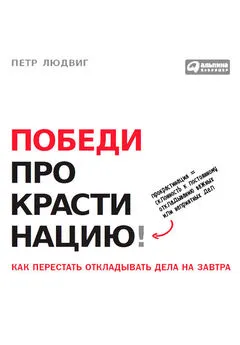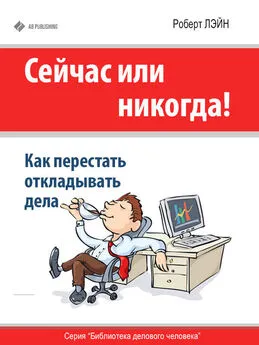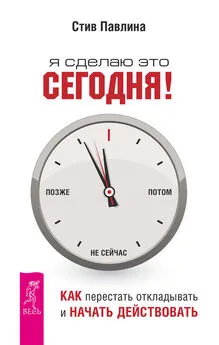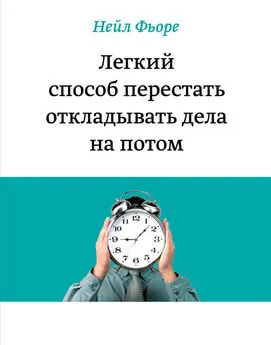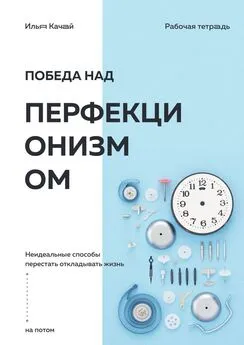Петр Людвиг - Победи прокрастинацию! Как перестать откладывать дела на завтра
- Название:Победи прокрастинацию! Как перестать откладывать дела на завтра
- Автор:
- Жанр:
- Издательство:Array Литагент «Альпина»
- Год:2014
- Город:Москва
- ISBN:978-5-9614-3557-3
- Рейтинг:
- Избранное:Добавить в избранное
-
Отзывы:
-
Ваша оценка:
Петр Людвиг - Победи прокрастинацию! Как перестать откладывать дела на завтра краткое содержание
Победи прокрастинацию! Как перестать откладывать дела на завтра - читать онлайн бесплатно ознакомительный отрывок
Интервал:
Закладка:
17. Baumeister, R.F., Muraven, M., Tice, D.M . Ego depletion: A resource model of volition, self-regulation, and controlled processing // Social Cognition. 2000. Vol. 18. № 2. P. 130–150.
18. Baumeister, R.F., Tierney, J . Willpower Rediscovering the Greatest Human Strength. London: Penguin Books, 2012.
19. Baumeister, R.F . Choking under pressure: Self-consciousness and paradoxical effects of incentives on skillful performance // Journal of Personality and Social Psychology. 1984. Vol. 46. № 3. P. 610–620.
20. BBC. 1978: Mass suicide leaves 900 dead // BBC.com [online]. URL: http://news.bbc.co.uk/onthisday/hi/dates/stories/november/18/newsid_2540000/2540209.stm
21. Berridge, K.C., Kringelbach, M.L . Affective neuroscience of pleasure: reward in humans and animals // Psychopharmacology. 2008. № 3. P. 457–480.
22. Bower, G.H . Mood and memory // American Psychologist. 1981. Vol. 36. № 2. P. 129–148.
23. Brickman, P., Coates, D., Janoff-Bulman, R . Lottery winners and accident victims: is happiness relative? // Journal of personality and social psychology. 1978. Vol. 36. № 8. P. 917–927.
24. Brocas, I., Carrillo, J.D . The psychology of economic decisions. 2nd ed. New York: Oxford University Press, 2003–2004.
25. Brown, M . Comfort Zone: Model or metaphor? // Australian Journal of Outdoor Education. 2008. Vol. 12. № 1. P. 3–12.
26. Brugger, P., Landis, T., Regard, M. A «sheep-goat effect» in repetition avoidance: Extra-sensory perception as an effect of subjective probability? // British Journal of Psychology. 1990. Vol. 81. № 4. P. 455–468.
27. Christakis, N.A., Fowler, J.H . Connected: the surprising power of our social networks and how they shape our lives: how your friends‘ friends‘ friends affect everything you feel, think, and do. New York: Back Bay Books, 2009.
28. Christakis, N.A., Fowler, J.H . Dynamic spread of happiness in a large social network: longitudinal analysis over 20 years in the Framingham Heart Study // British Medical Journal. 2008. № 337.
29. Critchley, M . Modes of reaction to central blindness // Proceedings of the Australian Association of Neurologists. 1968. Vol. 5. № 2. P. 211.
30. Csíkszentmihályi, M . Beyond boredom and anxiety. San Francisco: Jossey-Bass Publishers, 1975.
31. Csíkszentmihályi, M . Creativity: flow and the psychology of discovery and invention. New York: HarperCollins Publishers, 1997 a .
32. Csíkszentmihályi, M . Finding flow: the psychology of engagement with everyday life. New York: Basic Books, 1997 b .
33. Csíkszentmihályi, M . Finding flow: the psychology of engagement with everyday life. New York: BasicBooks, 2008 а .
34. Csíkszentmihályi, M . Flow: the psychology of optimal experience. New York: HarperPerennial, 1991.
35. Csíkszentmihályi, M . Flow: the psychology of optimal experience. New York: Harper Perennial, 2008 b .
36. Csíkszentmihályi, M . Optimal experience: psychological studies of flow in consciousness. Cambridge: Cambridge University Press, 1992.
37. Darwin, C . The descent of man: and selection in relation to sex. London: Penguin, 2004.
38. Di Tella, R., Haisken-De New, J., Macculloch, R . Happiness adaptation to income and to status in an individual panel // Journal of Economic Behavior. 2010. Vol. 76. № 3. P. 834–852.
39. Diamandis, P.H., Kotler, S . Abundance: the future is better than you think. New York: Free Press, 2012.
40. Diener, E., Lucas, R.E., Scollon, C.N . Beyond the Hedonic Treadmill: Revising the Adaptation Theory of Well-Being // Diener, E . The science of well-being. New York: Springer Netherlands, 2009. P. 103–118.
41. Du Plessis, E . The branded mind: what neuroscience really tells us about the puzzle of the brain and the brand. Philadelphia: Kogan Page, 2011.
42. Easterlin, R.A . Income and Happiness: Towards a Unified Theory // The Economic Journal. 2001.Vol. 111. № 473. P. 465–484.
43. Fairclough, S.H., Houston, K . A metabolic measure of mental effort // Biological psychology. 2004. Vol. 66. № 2. P. 177–190.
44. Ferrari, J.R . Procrastination as self-regulation failure of performance: Effects of cognitive load, self-awareness, and time limits on «working best under pressure» // European Journal of Personality. 2001. Vol. 15. № 5. P. 391–406.
45. Frankl, V.E . Man’s search for meaning. Boston: Beacon Press, 2006.
46. Fuoco, M.A . Trial and error: They had larceny in their hearts, but little in their heads // Pittsburgh Post-Gazette. 1996-05-21.
47. Gailliot, M.T., Baumeister, R.F., Dewall, C.N., Maner, J.K., Plant, E.A., Tice, D.M., Brewer, L.E., Schmeichel, B.J . Self-control relies on glucose as a limited energy source: Willpower is more than a metaphor // Journal of Personality and Social Psychology. 2007. Vol. 92. № 2. P. 325–336.
48. Gallup. Gallup.com: Daily News, Polls, Public Opinion on Politics, Economy, Wellbeing, and World [online]. 2013. URL: http://www.gallup.com
49. Gilbert, D.T., Ebert, J.E . Decisions and revisions: the affective forecasting of changeable outcomes // Journal of personality and social psychology. 2002. Vol. 82. № 4. P. 503–514.
50. Gilbert, D.T . Stumbling on happiness. New York: A.A. Knopf, 2006.
51. Glucksberg, S . The influence of strength of drive on functional fixedness and perceptual recognition // Journal of Experimental Psychology. 1962. Vol. 63. № 1. P. 36–41.
52. Gneezy, U., Rustichini, A.A . Fine Is a Price The Journal of Legal Studies. 2000. Vol. 29. № 1. P. 1–17.
53. Goklany, I.M . The improving state of the world: why we‘re living longer, healthier, more comfortable lives on a cleaner planet. Washington (DC): Cato Institute, 2007.
54. Grawe, K . Neuropsychotherapy: How the Neurosciences Inform Effective Psychotherapy. New Jersey: Routledge, 2007.
55. Hagger, M.S., Wood, C., Stiff C., Chatzisarantis, N.L.D . Ego depletion and the strength model of self-control: A meta-analysis // Psychological Bulletin. 2010. Vol. 136. № 4. P. 495–525.
56. Haidt, J . The happiness hypothesis: finding modern truth in ancient wisdom. New York: Basic Books, 2006.
57. Halford, G.S., Baker, R., McCredden, J.E., Bain, J.D. How many variables can humans process? // Psychological Science. 2005. Vol. 16. № 1. P. 70–76.
58. Haney, C ., Banks, C., Zimbardo, P. Interpersonal dynamics in a simulated prison // International Journal of Criminology and Penology. 1973 a . № 1. P. 69–97.
59. Haney, C., Banks, W.C., Zimbardo, P.G . Study of prisoners and guards in a simulated prison // Naval Research Reviews. 1973 b . № 9. P. 1–17.
60. Harber, K., Zimbardo, P.G., Boyd, J.N . Participant Self-Selection Biases as a Function of Individual Differences in Time Perspective // Basic and Applied Social Psychology. 2003. Vol. 25. № 3. P. 255–264.
61. Harris, S., Sheth, S.A., Cohen, M.S . Functional neuroimaging of belief, disbelief, and uncertainty // Annals of Neurology. 2008. Vol. 63. № 2. P. 141–147.
62. Haub, C . How Many People Have Ever Lived on Earth? Population Reference Bureau [online]. 1995, 2002. URL: http://www.prb.org/Articles/2002/HowManyPeopleHaveEverLivedonEarth.aspx.
63. Heyman, J., Ariely, D . Effort for Payment: A Tale of Two Markets // Psychological Science. 2004. Vol. 15. № 11. P. 787–793.
64. Hilbert, M., López, P . The World’s Technological Capacity to Store, Communicate, and Compute Information // Science. 2011. № 6025. P. 60–65.
65. Hill, A.L., Rand, D.G., Nowak, M.A., Christakis, N.A . Emotions as infectious diseases in a large social network: the SISa model // Proceedings of the Royal Society B: Biological Sciences. 2010. Vol. 277. № 1701. P. 3827–3835.
66. Howes, M.J., Hokanson, J.E., Loewenstein, D.A . Induction of depressive affect after prolonged exposure to a mildly depressed individual // Journal of personality and social psychology. 1985. Vol. 49. № 4.
67. Hulme, O . Comparative neurobiology: Hedonics& Happiness. Vancouver (Canada): University of British Columbia, 2010.
68. Imai, M . Kaizen: the key to Japan‘s competitive success. New York: McGraw-Hill, 1986.
69. Isen, A.M . Psychological and biological approaches to emotion. Hillsdale (N.J.): L. Erlbaum Associates, 1990. S. 75–94.
70. Iyengar, S.S . The art of choosing. New York: Twelve, 2010.
71. Iyengar, S.S., Wells, R.E., Schwartz, B . Doing Better but Feeling Worse: Looking for the «Best» Job Undermines Satisfaction // Psychological Science. 2006. Vol. 17. № 2. P. 143–150.
72. Iyengar, S.S, Lepper, M.R . When choice is demotivating: Can one desire too much of a good thing? // Journal of Personality and Social Psychology. 2000. Vol. 79. № 6. P. 995–1006.
73. Iyengar, S.S., Huberman, G., Jiang, G. How Much Choice is Too Much? Contributions to 401(k) Retirement Plans // Pension Design and Structure: New Lessons from Behavioral Finance. 2005.
74. Iyengar, S.S., Lepper, M.R . Rethinking the value of choice: A cultural perspective on intrinsic motivation // Journal of Personality and Social Psychology. 1999. Vol. 76. № 3. P. 349–366.
75. Jackson, S., Csikszentmihalyi, M . Flow in sports. Champaign (IL): Human Kinetics, 1999.
76. Johnson-Laird, P.N . Mental models: towards a cognitive science of language, inference and consciousness. 5th ed. Cambridge (Mass): Harvard University Press, 1993.
77. Kahneman, D., Krueger, A.B . Developments in the measurement of subjective well-being // The journal of economic perspectives. 2006. Vol. 20. № 1. P. 3–24.
78. Kalina, K . Základy klinické adiktologie. Praha: Grada, 2008.
79. Kalina, T., Vána, J . Sinice, rasy, houby, mechorosty a podobné organismy v současné biologii. Praha: Karolinum, 2005.
80. Keely, L.C . Why isn’t growth making us happier? Utility on the hedonic treadmill // Journal of Economic Behavior. 2005. Vol. 57. № 3. P. 333–355.
81. Kinsella, K.G . Changes in life expectancy 1900–1990 // The American Journal of Clinical Nutrition. 1992. Vol. 55. № 6. P. 1196–1202.
82. Kringelbach, M.L . The Functional Neuroanatomy of Pleasure and Happiness // Discovery Medicine. 2010. Vol. 9. № 49. P. 579–587.
83. Krug, E.G., Mercy, J.A., Dahlberg L.L., Zwi, A.B . The world report on violence and health // The Lancet. 2002. № 9339. P. 1083–1088.
84. Kruger, J., Dunning, D . Unskilled and unaware of it: how difficulties in recognizing one‘s own incompetence lead to inflated self-assessments // Psychology. 2009. № 1. P. 30–46.
85. Lally, P., Van Jaarsveld, C.H.M., Potts, H.W.W., Wardle, J . How are habits formed: Modelling habit formation in the real world // European Journal of Social Psychology. 2010. Vol. 40. № 6. P. 998–1009.
86. Ledoux, J . The emotional brain: the mysterious underpinnings of emotionnal life. New York: Simon, 1998.
87. Lepper, M.R., Greene, D., Nisbett, R.E . Undermining children‘s intrinsic interest with extrinsic reward: A test of the «overjustification» hypothesis // Journal of Personality and Social Psychology. 1973. Vol. 28. № 1. P. 129–137.
Читать дальшеИнтервал:
Закладка:
